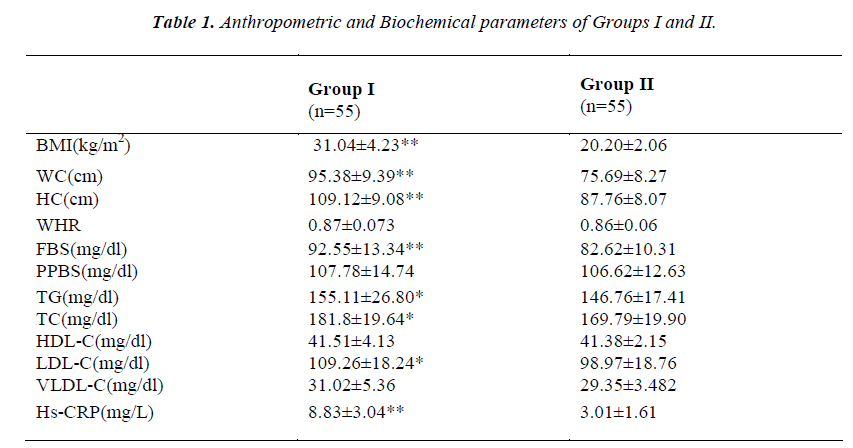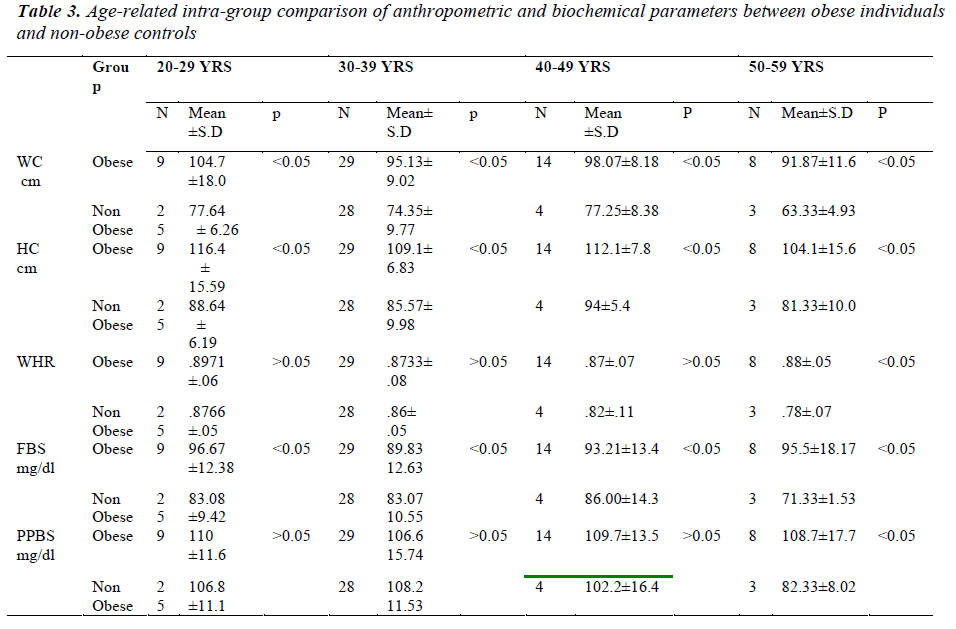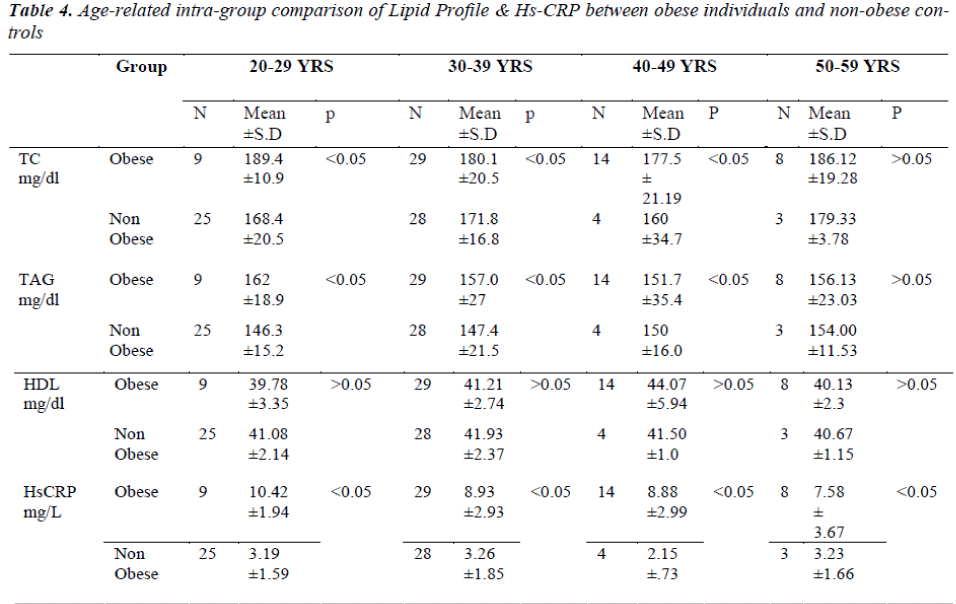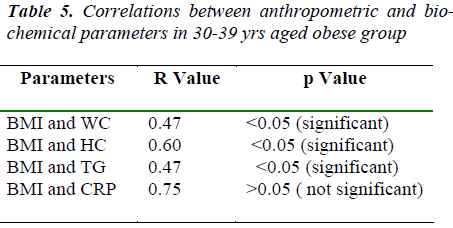- Biomedical Research (2012) Volume 23, Issue 1
High sensitive C-reactive protein, an independent and early novel inflammatory marker in healthy obese women
Nirmitha Dev* and Sara Rani MarcusDepartment of Biochemistry, MS Ramaiah Medical College, Bangalore, India
- *Corresponding Author:
- Nirmitha Dev
Department of Biochemistry
M S Ramaiah Medical College
Bangalore 560054
Karnataka, India
Accepted date: May 25, 2011
Abstract
It has been shown that low grade inflammatory state is associated with cardiovascular risk. High sensitive C-reactive protein (hs-CRP), a non specific inflammatory marker has been shown to be increased in metabolic syndrome a risk state for the development of cardiovascular disease and type-2 Diabetes mellitus. Obesity is a predisposing condition to metabolic syndrome. Therefore, this study was intended to measure hs-CRP levels in obese females to assess their risk status. 55 healthy adult obese females with BMI>23kg/m2 were taken as cases and 55 age matched healthy adult non-obese females with BMI<23kg/m2 were taken as controls. Anthropometric measurements (Waist circumference, Hip circumference & Waist to Hip ratio) and biochemical estimations (blood glucose, high sensitive C - reactive protein & lipid profile) were carried out. There was significant increase in Waist circumference, fasting blood sugar, Total cholesterol, Triglyceride, VLDL, LDL levels and hs-CRP levels in obese females as compared to controls. Blood glucose levels & lipid profile were within the reference range in both obese and non obese females. hs-CRP did not show any correlation with blood glucose or lipid profile. hs-CRP behaved as an independent inflammatory marker in obesity. Therefore, hs-CRP might be an early novel marker of inflammation, for identifying the obese females who are at risk for obesity related co-morbidities.
Keywords
obesity; waist-to-hip ratio; body mass index; hs-CRP
Introduction
Obesity is a chronic disorder prevalent in both developed and developing countries. It has been found that, in India 55% of women between the age group of 20 and 69 years are overweight [1]. Obesity is one of most significant contributors to morbid conditions like metabolic syndrome, type-2 Diabetes mellitus and cardiovascular disorders (CVD) [1]. It has been shown that proinflammatory molecules contribute to the development of complications in obesity [2]. hs-CRP a non specific inflammatory marker is synthesized by liver in response to stimulation by proinflammatory cytokines derived from several sources including adipocytes [4]. It is seen that hs-CRP is increased in metabolic syndrome, a risk state for the development of cardiovascular disease and type-2 Diabetes mellitus. Therefore, this study was intended to measure hs-CRP levels in healthy obese females who are at risk for metabolic syndrome. Also, there are very limited studies on the role of hs-CRP in female obese individuals.
Materials and Methods
The study was conducted on patients attending the Endocrinology Department at M S Ramaiah Medical College, Bangalore in South India. The study was conducted after taking the required Ethical clearance from the Institute and all women who signed the informed consent participated in the study. Two groups of normotensive, normoglycemic adult females of the age group 20-70yrs were selected. Group-I as cases comprised of 55 women with BMI>23kg/m2 and Group II - 55 non-obese women as controls with BMI<23 kg/m2 as per WHO standards for Asians [9].Women aged between 20-70 years were included. Subjects with history of diabetes mellitus, endocrinal disorders, smoking, hypertension, cardiac diseases, bronchial asthma, acute or chronic inflammatory diseases, autoimmune diseases, on medications like steroids, antipsychotic drugs, women with menstrual disorders, PCOD & all known parameters that may affect CRP or lipid profile were excluded from the study. Weight, Height, Waist circumference & Hip circumference; BMI (body weight in Kg/height in m2) and Waist to hip ratio (WHR) were calculated were recorded in non-obese and obese group.
Waist circumference was taken midway between the inferior margin of the last rib and the crest of the ilium in a horizontal plane. Hip circumference (HC) around the pelvis at the point of maximal protrusion of the buttocks. Cut off points for obese Asian women were BMI>23kg/m2 waist>80cm, WHR>0.88 as per WHO standards for Asians [9]. Blood samples were taken for the determination of the fasting blood sugar, post prandial blood sugar, lipid profile and high-sensitivity C - reactive protein. Estimation of serum High-sensitivity C - reactive protein (hs-CRP) was carried out by turbidimetry latex-high sensitivity kit (Biosystems S.A. Costa Brava, Barcelona [Spain]) method [10]. Blood glucose was assayed by the glucose oxidase kit (Vital Diagnostics Pvt. Ltd, Mumbai) method [11], serum cholesterol by the end point enzymatic kit (Bio systems, S.A Barcelona [Spain]) method [12], HDL-cholesterol by phosphotungstate Precipitation kit (Bayer Diagnostics, Baroda) method [13],serum triacylglycerol by glycerol phosphate oxidase kit (vital diagnostics Pvt Ltd, Mumbai) method [13],LDL and VLDL were calculated from the estimated values of cholesterol, triglyceride and HDL-C, using the equation of Frieldwald et al [13]
Statistical analysis
Values were expressed as Mean ± SD. Statistical comparisons were carried out by student‘t’ test and ANOVA tests. Correlations were done by calculating Pearson’s correlation coefficient. All statistical analysis were done at 5% level of significance using SPSS software, version 16.
Results
Results are shown in the Tables 1, 2, 3, 4 & 5 Waist circumference & Hip circumference were significantly elevated in obese group compared to the control group. FBS, PPBS and lipid profile were in the normal range. Although there was a significant increase in FBS, total cholesterol, TG, LDL, VLDL & Hs-CRP levels in the obese group when compared to non-obese group but there was no significant change in WHR and HDL-C levels when compared with non obese Group (Table 1).
There was a positive correlation between Waist circumferences and FBS(r=0.267, P=0.49), TG(r=0.286, P=0.034) and TC(r=0.289, P=0.033) in obese group. The increase in both hs-CRP and LDL-C in obese group was independent of waist circumference. There was no correlation with WHR (Table 2).
When study group was further divided based on age into 20-29 yrs, 30-39 yrs, 40-49 yrs and 50-59 yrs. Among the age groups(20-29 yrs, 30-39 yrs, 40-49 yrs), there was significant increase in waist and Hip circumferences & biochemical parameters such as FBS, Total Cholesterol, Triacylglycerol and Hs-CRP in obese individuals compared to non-obese controls. In the age group between 50- 59 yrs, there was significant increase in waist and Hip circumferences, WHR & biochemical parameters such as FBS, PPBS and Hs-CRP obese individuals compared to non-obese controls (Tables 3, 4).But more significant finding among 30-39 yrs age group, there was a positive correlation between BMI and WC (r=0.474, P=0.019), HC (r=0.602, P=0.002), TG (r=0.479, P=0.018) and VLDL-C (r=0.479, P=0.018) in obese persons. But controls of same age group showed negative correlations between BMI and hs-CRP(r=-0.613, P=0.002).The increase in hs-CRP & LDL-C in obese persons was independent of WC and BMI (Table 5).
Discussion
The expansion of the adipose tissue leads to the altered production of proinflammatory molecules and results in low-grade inflammation. The increase in hs-CRP levels indicates a state of low-grade inflammation in the obese group [14]. Cut-off limits >3 mg/L in Hs-CRP levels indicates low-grade inflammation, which in turn might be a prognostic marker for further cardiovascular events [15]. In the present study, high hs-CRP levels in obese subjects may suggest the ongoing inflammation. The increase in hs-CRP levels in the younger & middle aged obese group shows that even they are at risk of developing obesity related co-morbidities. Thus, we can target obese population of younger age group at the earliest, through estimation of hs-CRP. The present study also shows that hs-CRP levels are independent of BMI, waist circumference, FBS & LDL-C.
BMI is a measure of mass, but doesn’t represent central adiposity. Waist circumference and W/H ratio are preferable indices for visceral adiposity. In the present study waist circumference was significantly higher in the obese group compared with non- obese group. WHR did not show any significant change in obese group when compared with non-obese group. Also waist circumference is positively related to FBS, Total Cholesterol & Triacylglycerol which shows that in women, the waist circumference appeares more closely related to the metabolic variables than the WHR. This study also shows that waist circumference can be better measure of visceral obesity associated with metabolic abnormalities that increase the risk of type 2 diabetes mellitus [19].
In obesity, there is altered glucose metabolism, which may be due to significant reduction in the insulin sensitivity [20].The fasting and postprandial blood sugar levels were within normal limits in obese. However fasting blood sugar levels higher in obese persons when compared to non-obese controls shows that obese are predisposed to develop metabolic syndrome. The lipid profile, which included Total Cholesterol, triacylglycerol, HDLC, LDL and VLDL, were within normal limits showing that obese subjects in this study were not dyslipidemic. However, Total Cholesterol, triacylglycerol, LDL and VLDL were increased in obese compared to non-obese. This shows that obese individuals with higher BMI tend to have altered lipid profile levels.
Though, the FBS, PPBS, lipid profile & hs-CRP were increased in obese females, there was no positive correlation between hs-CRP and other biochemical parameters. Therefore, hs-CRP behaves as an independent marker in obese females. It can also be noted that all biochemical parameters of this study are with in the reference ranges and only hs-CRP being increased i.e. even before dyslipidemia & insulin resistance sets in, there is an onset of inflammation which can be identified by the measurement of hs-CRP.
Thus hs-CRP can be an early novel inflammatory marker in the healthy obese females. Interventional measures like change in nutritional habits and increase in physical activity in order to lose weight and improve insulin sensitivity also reduce hs-CRP levels [22]. Thus, hs-CRP can also be used as a tool for assess the prognosis in obese females also.
Major limitation of this study is that, this is a cross sectional study with small sample size. Therefore a. prospective study is required to stratify the risk category among obese. Moreover study of pro-inflammatory molecules like adipokines- TNF-a, leptin & resistin in overweight and obese subjects along with hs-CRP may help to elucidate the role of inflammation in obesity.
Conclusion
The present study suggests that obesity is associated with pro-inflammatory changes as evident by increase in hs- CRP levels in apparently healthy obese women. Thus, in normal, healthy, obese individuals the CRP levels can be used as a non specific marker for inflammatory processes and an independent marker of cardiovascular disease, type 2 diabetes and metabolic syndrome.
Acknowledgment
We are thankful to Dr Vasudha K.C and my colleagues in the department for their help, support and co-operation during this research work. I am extremely thankful for the statistical analysis done by Mr. Shivakumar, MSRMC, Bangalore.
References
- World Health Organization Controlling the global obesity epidemic. Available at: http://www.who.int/ nutrition/ topics/obesity/en/index.html.
- Trayhurn P, Wood IS. Adipokines: inflammation and the pleiotropic role of white adipose tissue. Br J Nutr 2004; 92: 347-355.
- Weisberg SP, McCann, Desai M, et al. Obesity is associated with macrophage accumulation in adipose tissue. J Clin Invest 2003; 112: 1796-1808.
- Sartipy P, Loskutoff DJ. Monocyte chemoattractant protein-1 in Obesity and insulin resistance”, Proc. Natl. Acad. Sci. U. S. A, 2003; 100: 7265-7270.
- Li JJ, Fang CH. C-reactive protein is not only an inflammatory marker but also a direct cause of Cardiovascular diseases”, Medical Hypothesis. 2004; 62:499- 506.
- Xu H., et al, Chronic inflammation in fat plays a crucial role in the development of obesity-related insulin resistance, J Clin Invest 2003; 112: 821-1830.
- Reddy KS, Prabhakaran D, Chaturvedi V, Jeemon P, et al 2006 Methods for establishing a surveillance system for cardiovascular diseases in Indian industrial populations. Bull World Health Organ 2006; 24: 461-469.
- Schenck-Gustafsson K. Risk factors for cardiovascular disease in women Maturitas 2009; 63:186-190.
- WHO/IASO/IOTF. The Asia-Pacific perspective: redefining obesity and its treatment. Health Communications Australia: Melbourne, 2000.
- Rifai N, Tracy RP, Ridker PM. Clinical efficacy of an automated high sensitivity C-reactive protein assay. Clin Chem 1999; 45: 2136-2141.
- Trinder P. Determination of blood glucose. J Clin Path 1959; 22: 246.
- Allain CA. Determination of Total cholesterol and HDL-cholesterol. Clinical Chemistry 1974; 20: 470.
- Tietz NW. Clinical chemistry and Molecular Diagnostics. , W.B. Saunders company 2006; 555-672.
- Chambers JC, Eda S, Bassett P, Karim Y, Thompson SG, Gallimore JR et al. C-reactive protein, Insulin Resistance, Central obesity and Coronary heart disease risk in Indian Asians from the United Kingdom compared with European Whites. Circulation 2001; 104 (2): 145-150.
- Ridker PM. Clinical application of C -reactive protein for Cardiovascular diseases detection and prevention”, Circulation 2003; 107:363-369.
- Danesh J, Wheeler JG, Hirschfield GM, Eda S, Eiriksdottir G, Rumley A et al, C-reactive protein and other circulating markers of inflammation in the prediction of Coronary Heart Disease, N Eng J Med 2004; 350 (14): 1387-1397.
- Chaikate S, Harnroongroj T, Chantaranipapong Y., et al. C-reactive Protein Interleukin-6 and tumor necrosis factor-alpha levels in overweight and healthy Adults. South Asian J Trop Med Public Health 2006 37 (2): 374-381.
- Ridker PM. Rosuvastatin in the primary prevention of cardiovascular disease among patients with low levels of Low- density lipoprotein cholesterol and elevated high sensitivity C-reactive protein: rationale and design of the JUPITER trial. 2003, 108: 2292-2229.
- Pouliot MC, Després P, Lemieux S, et al. Waist circumference and abdominal sagittal diameter: Best simple anthropometric indexes of abdominal visceral adipose tissue accumulation and related cardiovascular risk in men and women. Am J Cardiol 1994; 73: 460- 468.
- Weiss R, Cali AM, Dziura J, et al. Degree of obesity and glucose allostasis are major effectors of glucose tolerance dynamics in obese youth. Diabetes Care, 2007; 30: 1845-1850.
- Nakanishi S, Yamane K, Kamel N. Elevated C-reactive protein is a risk factor for the development of type-2 diabetes in Japanese Americans. Diabetes Care 2003; 26: 2754-2757.
- Albert MA, Glynn RJ, Ridker PM. Effect of physical activity on Serum C-reactive protein”, Am J Cardiol, 2004; 93: 221-225.




